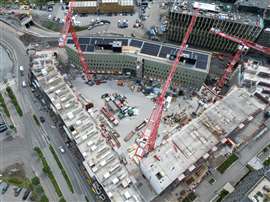Wolff tower cranes work out in Norway
21 November 2024
 Three Wolff tower cranes helping to build the new head office for construction contractor Veidekke. The building should be ready for occupation in January 2025. Photo: Wolffkran
Three Wolff tower cranes helping to build the new head office for construction contractor Veidekke. The building should be ready for occupation in January 2025. Photo: Wolffkran
Five of the same model tower cranes are working on two projects to modernise a district of the city of Oslo.
All the cranes are 16 tonne capacity Wolff 7534.16 Clear flat tops and all are working on sites in Ulven, an eastern district of Norway’s capital city. Ulven is known as an industrial area and is now undergoing urban modernisation.
The cranes are working for Veidekke, the largest Norwegian construction contractor, on two projects already nearing completion. For two years a pair of the 7534.16 Clear flat tops have been working to build the Ulvenkroken residential apartment complex consisting of 180 units.
Both cranes have a capacity of 16.5 tonnes, 60 metre jibs and 5 tonne tip loads. They are lifting and placing prefabricated sections, steel and concrete. For a period of eight days the two cranes poured the concrete to make five elevator shafts using a continuous slipform process. They worked around the clock until each pour was finished.
The crane manufacturer said an important feature of the cranes for this job was their 75 kW hoist winches giving a maximum hoisting speed of 185 metres a minute.
Sustainable economics
 Oslo’s previously industrial Ulven district is subject to a programme of urban redevelopment, largely as a residential area. Photo: Wolffkran
Oslo’s previously industrial Ulven district is subject to a programme of urban redevelopment, largely as a residential area. Photo: Wolffkran
Both cranes were on foundation anchors embedded into the foundation of the building. “Thanks to our two-part foundation anchor system, where only the cost-effective anchor part remains in the ground and the high-quality part can be reused, this solution is particularly sustainable and economical for the customer,” said Sindre Aamodt, Wolffkran Norge service technician.
One challenge was interference from two of five tower cranes on a neighbouring project oversailing the Ulvenkroken site. Where they slewed across the working area of the Wolff cranes the collision avoidance systems across both sites were co-ordinated by the Wolffkran team.
“In addition, the working radii of the Wolff cranes had to be co-ordinated with the adjacent railway tracks, pedestrian paths and roads, and several restricted zones had to be programmed,” Aamodt explained.
The other three of the five Wolff towers are working, also for Veidekke, to construct its new headquarters building, a few kilometres from the other job. Sustainable materials and alternative energy are a key element of the new building, to the point where Norway’s Crown Prince Haakon visited the site. He climbed one of the cranes and had a go at operating it.
These two projects were the first time Veidekke had worked with Wolffkran. Morten Opstad Aarseth, Veidekke project manager, commented, “Wolffkran has supported us extensively throughout the entire project phase. Whether during the planning phase, in obtaining permits through the railway authorities, setting up the construction site in co-ordination with the neighbouring site, managing the complex logistics during the crane assembly, or handing the demanding night shifts – the team was always by our side with competence and professionalism. A successful debut.”
CONECTAR-SE COM A EQUIPE





